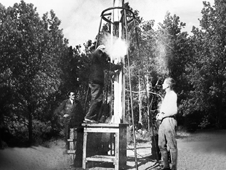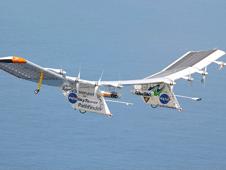Exploration
This Month in Exploration - August
08.01.08
 GIRD team feeding liquid oxygen to the "09" rocket. Credit: NASA
GIRD team feeding liquid oxygen to the "09" rocket. Credit: NASA
100 Years Ago
August 8, 1908: Less than five years after the Wright brothers accomplished the first airplane flights at Kitty Hawk, N.C., Wilbur Wright → made his first European flight south of Le Mans, France. He completed more than 100 flights near Le Mans in the coming year.
75 Years Ago
August 17, 1933: The Group for the Investigation of Reactive Engines and Reactive Flight (GIRD) launched the first Soviet rocket fueled by liquid propellant. The "09" rocket flew for 13 seconds and reached an altitude of about 1,200 feet.
50 Years Ago
August 3, 1958: The USS Nautilus, the first nuclear powered submarine, reached the North Pole. During Operation Sunshine, Commanding Officer William Anderson and his crew became the first to cross the North Pole by ship.
August 19, 1958: Dr. Thomas Keith Glennan → was sworn in at the White House as NASA's first Administrator. Dr. Hugh Dryden, head of the National Advisory Committee for Aeronautics, was appointed his Deputy Administrator. Prior to joining NASA, Glennan served as president of the Case Institute of Technology in Cleveland, Ohio. He returned to the university in 1961 following his NASA service.
 Glennan, the new NASA Administrator, and Dryden (left), Deputy Administrator, are sworn in as President Eisenhower looks on. Credit: NASA
Glennan, the new NASA Administrator, and Dryden (left), Deputy Administrator, are sworn in as President Eisenhower looks on. Credit: NASA
35 Years Ago
August 5, 1973: The USSR launched the Mars 6 → orbiter and lander, which was designed to study the Martian atmosphere and surface. It arrived at Mars on March 12, 1974, but only transmitted data for a few minutes before slamming into the surface.
30 Years Ago
August 12, 1978: NASA launched ISEE-3 →, one of three International Sun-Earth Explorer (ISEE) satellites developed through a partnership between NASA and the European Space Agency. ISEE-1 and 2, a mother-daughter pair, were launched on October 22, 1977. Researchers used the satellites to study and explore Earth's magnetosphere using instrumentation that measured energetic particles, plasmas, waves and fields. After completing its original mission, ISEE-3 was renamed the International Cometary Explorer and commissioned to study comet P/Giacobini-Zinner.
25 Years Ago
August 30, 1983: Guion "Guy" Bluford became the first African American astronaut in space when he flew aboard space shuttle Challenger during the STS-8 mission. STS-8 was the first night launch and landing of a shuttle.
|
TO SUBSCRIBE: Get NASA's This Month in Exploration in your inbox every month. Send us an e-mail today. > Read More |
August 24, 1988: McDonnell Douglas began assembling the first C-17 aircraft at the company’s Long Beach, Calif. facilities. The U.S. Air Force uses the C-17 to transport troops and cargo. Today Boeing manufactures the plane.
15 Years Ago
August 31, 1993: Russia launched Meteor 2-21, the last of the Meteor 2 spacecraft. The satellite helped gather data on weather and radiation. Meteor 2-21’s payload included the German/Italian Temisat small space facility, which was designed to collect environmental data using terrestrial sensors.
10 Years Ago
August 6, 1998: NASA's remotely piloted Pathfinder-Plus → set an altitude record for propeller-driven aircraft by flying at an altitude of 80,201 feet. This solar-powered aircraft flew at speeds between 15 and 25 miles per hour above Kauai, Hawaii.
 Pathfinder-Plus flight in Hawaii. Credit: Nick Galante/NASA Dryden
Pathfinder-Plus flight in Hawaii. Credit: Nick Galante/NASA Dryden
Five Years Ago
August 25, 2003: NASA launched the Space Infrared Telescope Facility using a Delta II rocket. This astronomy satellite, now known as the Spitzer Space Telescope, is the fourth and final member of NASA's Great Observatories. Spitzer's powerful infrared sensitivity is especially useful for investigating objects obscured by dust in space.
Present Day
August 1, 2008: A total eclipse → of the sun took place when the new moon passed directly between the sun and Earth. Observers in northern Greenland, the Arctic, central Russia, Mongolia and China saw the total eclipse. People in Northeastern North America, most of Europe and Asia only saw a partial eclipse.
August 11, 2008: NASA's Cassini spacecraft has flown past Saturn's brightest moon, Enceladus. While just 30 miles from the moon's surface, Cassini captured high resolution images of fractures, or "tiger stripes," caused by jets of icy water vapor at the south pole.
Emily Owens (Analex Corporation)
See Past Issues:
> This Month in Exploration Main